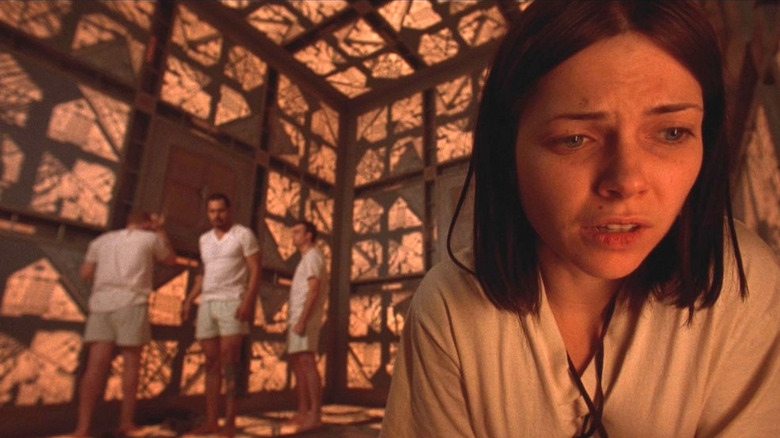
A decade after escape rooms became popular — in which a team of players play detective and complete tasks together in a shared space in order to accomplish a specific, time-sensitive goal — the exit games, as they're sometimes called, still have a stranglehold on popular culture, particularly in the movie theater. With recent movies like "Escape Room: Tournament of Champions" getting tons of attention, it's a good time to recommend some escape room horror movies to add to the watchlist.
But first, the criteria: an escape room horror movie doesn't have to feature an actual escape room in the workplace-teambuilding exercise sense, but it does need to have some sort of gameplay element or a grand design in which the designated "players" must try to survive a test — this separates this roundup list from the similar but divergent "captivity" film. Paul Sheldon of "Misery" has to pull some clever moves to try to escape the isolated homestead of his number one fan Annie, but she doesn't force him to wade through a pit of needles to find the key to his freedom, he's just locked in the house.
It's also why booby-trap extravaganza "The Collector" isn't present here; its protagonist may be having a terrible, horrible, no-good, very bad day trying to avoid a psychopath, but Arkin O'Brien doesn't have to solve puzzles so much as he must tiptoe and serpentine past a house of horrors he voluntarily entered. Besides, "Desperate criminal picks the wrong house to rob" is its own subgenre, counting "The Collector" alongside "The People Under the Stairs," "Don't Breathe," and many more.
Escape room movies have more than a captive in a room; countdowns, dangerous traps, and even rigged games all count in these stories that require sharp wits and steely resolve under the threat of a gnarly death.
Escape Room (2019)
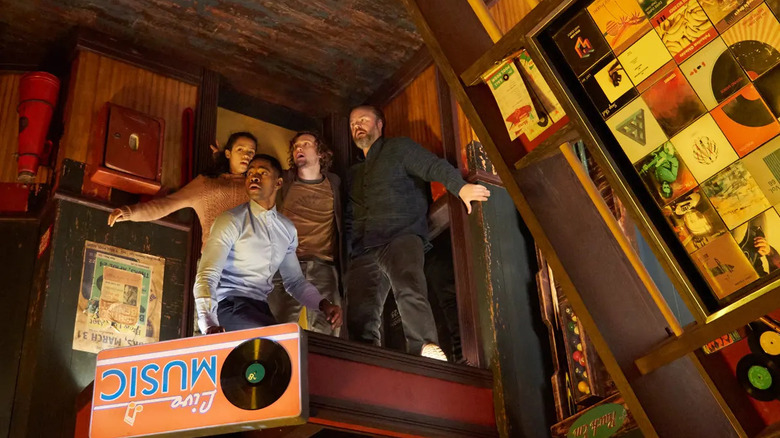
Adam Robitel's "Escape Room" is a good lateral move for fans of the hit Netflix series "Squid Game," each observing the haves culling the have-nots for sport. Six strangers are invited to solve puzzles and read clues, while the last one standing walks away with $10 grand.
In the beginning, the gameplay is a solid representation of the teamwork and bubbling neuroses that emerge from real-life escape rooms. This movie follows a "Cabin in the Woods" approach, where the setting changes according to the players' interactions with it. The puzzles and clues are closely tethered to each of the players, poking at some tender wound around their deepest shame and fears. Robitel (who previously directed the effective found-footage horror "The Taking of Deborah Logan") told hosts of The Witching Hour podcast, "If it's a movie about puzzles, then the characters need to be a puzzle." Otherwise, he said it's just a bore.
The result is leagues away from boring. Production designer Ed Thomas oversaw an array of traps including an oven room, an icy lakeside cabin, a topsy-turvy pool hall, and a grungy hospital. From room to room, the players scramble to retrieve a key or a code just in time to lose a member of their party in unfortunate ways.
Columbia Pictures gave the thumbs up for a sequel which was released in the summer of 2021 after several pandemic-related delays. "Escape Room: Tournament of Champions" brings back the sole survivors of the previous film, the same way winning tributes were being called up for the all-star round in the "Hunger Games" sequel.
Cube (1997)
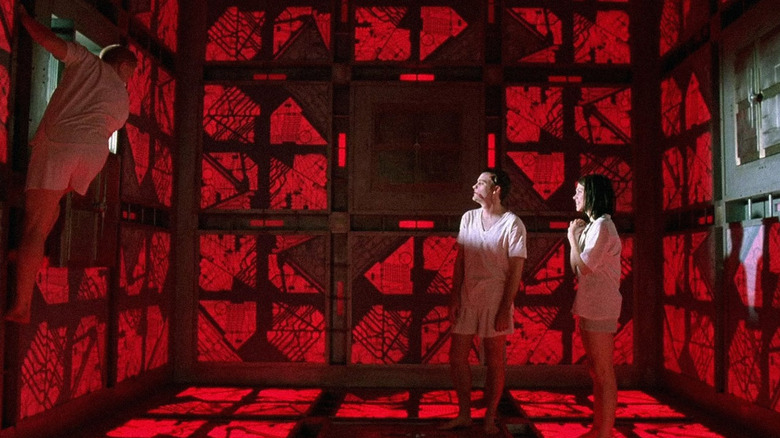
"You've got to save yourself from yourselves." That's the challenge as escape artist Rennes (Wayne Robson) puts it to his fellow captives in the 1997 Canadian mind-bender "Cube." A handful of random people — a student, doctor, cop, etc. — wake up in a large cube structure that feels like the inside of the Lament Configuration. The cube is connected to other rooms which may or may not be rigged with a series of flamethrowers, razor-thin wire grids, or corrosive acid.
Their efforts to escape make up the bulk of the movie, a simple concept from the mind of "Splice" director Vincenzo Natali, who wanted to tell a story that could be shot in a single location. With a $350,000 budget and the cinema magic of sliding colored panels, this cube represents exponentially more just like it; the characters move laterally from chamber to chamber but the actors are working on a plain platform, varied only by wall color and type of trap. From there, Natali lets the human condition flourish, putting pressure on the characters' allyship as trust dwindles and hunger becomes a more aggressive motivator. It becomes a tense tug-of-war between those trying to address the immediate dangers ahead of them, and those asking the million-dollar questions: who is behind this, and what do they want?
Doing a lot with just a little, "Cube" is an intelligent predecessor for escape room movies, priming the pump for the likes of "Saw" and even corporate horror like Joe Lynch's "Mayhem." A sequel, prequel, and a Japanese remake followed "Cube," but none could touch the original.
House On Haunted Hill (1999)
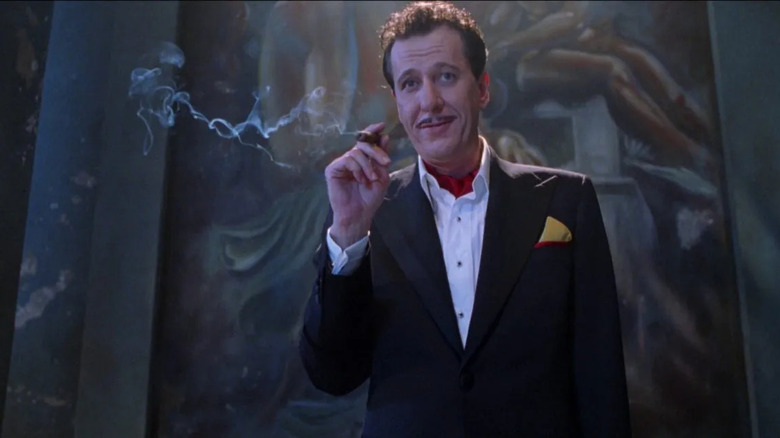
An October viewing staple, "House on Haunted Hill" is a go-to title for horror fans, whether referring to the 1959 William Castle feature (one of whose jump-scares landed at #37 on Bravo's 100 Scariest Movie Moments) or its superior Dark Castle Entertainment remake from 1999. It takes place at an allegedly haunted cliffside mansion, where the people summoned there are all in dire need of the reward that comes with escape.
The gameplay element is a financial incentive: the winner will emerge from the fortified building significantly richer. In the original, Vincent Price's peculiar fat cat Loren offered $10,000 to the victor, a tidy sum in 1959. When the Dark Castle remake of "House on Haunted Hill" was released four decades later, the cash pot (offered this time by Geoffrey Rush, though his character is named Price and he's clearly using the horror icon as a guiding star in his performance) swelled to a cool million.
The source of the alleged hauntings changed, as well. The specter-filled mansion is now a private residence converted from the Vannacutt Psychiatric Institute for the Criminally Insane, leading to a fantastic fourth-wall-breaking scare with an operating room and a handheld camcorder, one of many tight atmospheric, stylized sequences with eerie imagery. But the parameters of Robb White's original story (one of five he penned for William Castle productions) remained: survive a night of lockdown in this spooky house, and the money is all yours.
"House on Haunted Hill" is one of the few entries on this list that, according to its professed rules, could allow for multiple players to survive. But survival horror movies generally operate by Highlander rules: there can only be one.
No Escape Room (2018)
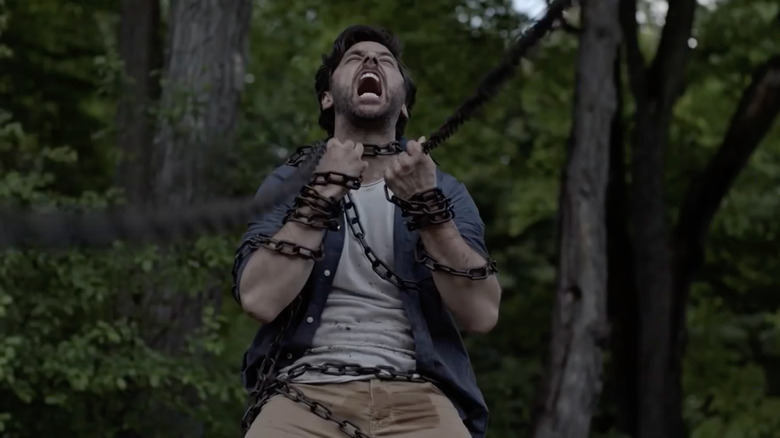
Originally released for the SyFy network in October of 2018, "No Escape Room" starts at a slower pace than most of its kind. Whereas the majority of these movies drop the audience in on the action with no preamble, Alex Merkin's ("House of the Witch") supernatural horror introduces its doomed father-daughter duo under better circumstances. The pair are on their way back from a botched bonding trip when car trouble strands them in a small, lonesome town. Looking for something to do while it's getting fixed, they try a local escape room in a sprawling mansion, the first of several bad decisions that put them in serious danger.
Together with three other escape room guests, they give up their cell phones, sign waivers (written on parchment, signed with a quill pen), and once the heavy doors shut behind them, the clock starts ticking. Host Josie (Brianna Barnes) tells them that they'll have to rely on their wits and each other, but that proves difficult as players disappear and bodies turn up.
The novelty of "No Escape Room" is in its paranormal angle; there's not really a flesh-and-blood killer pulling the strings, nor are there any Rube Goldberg dismemberment traps in this game. Instead, the true source of the "no escape" room is more cosmically grim, loosening its victims' grip on reality itself. Making the most of its made-for-TV parameters, the movie is more of a gloomy horror mystery than a balls-to-the-wall Mouse Trap game. There's the occasional jump-scare, but Merkin mostly goes for low-gore Gothic repulsion: writhing worms in the telephone, silhouettes and bedsheets, a crusty corpse reaching towards the screen. "No Escape Room" offers low-intensity entertainment for a windy night.
Nine Dead (2009)
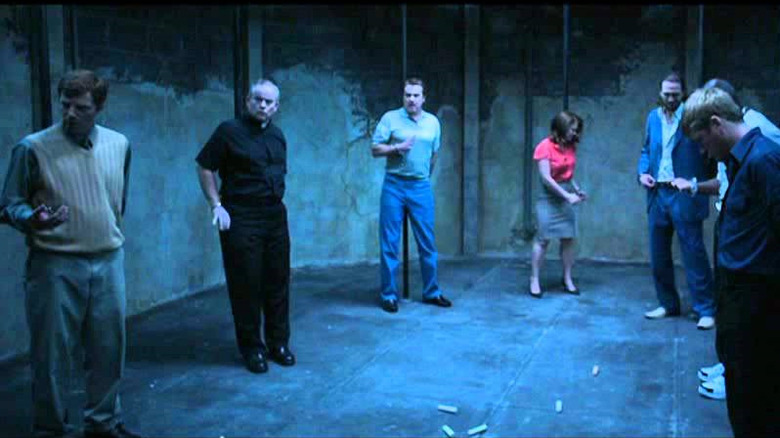
One common escape movie situation positions the truth as the key to freedom, where liberation only becomes possible once its players start confessing their sins and figuring out how they intersect. In these stories, the players are all pertinent to each other in some way, usually tethered by tragedy. The victims of "Saw III" were all directly involved in a hit-and-run collision that left a child dead. Among them is an eyewitness, a judge, and a driver, all (it's argued) bearing some responsibility for the pain felt by the boy's father, who faces some tough decisions as commanded by the Jigsaw.
Most of the "Saw" movies operate with the same structure, but one of the lesser-seen deadly-game thrillers to come in its wake is "Nine Dead," dropping in 2009 just a month after the Kevin Greutert-helmed sequel "Saw VI." In Chris Shadley's thriller, the doomed nine awaken in a dingy room, handcuffed to pipes. A masked figure plays the Jigsaw role, informing all present that they were chosen for a reason, and the assailant will return every ten minutes to execute one of them until they figure out that reason.
Few of these riffs can compete with the original creation from James Wan and Leigh Whannell, and "Nine Dead" doesn't quite reach those heights, but the journey is greater than the goofy reveal. It keeps the tension going with juicy secrets and adds a second, dread-fueled layer of horror that "Saw" custodians know well: how easily a single moment can pivot entire lives.
Read this next: The 31 Scariest Movie Scenes Ever
The post The 5 Best Escape Room Horror Movies appeared first on /Film.
0 Commentaires